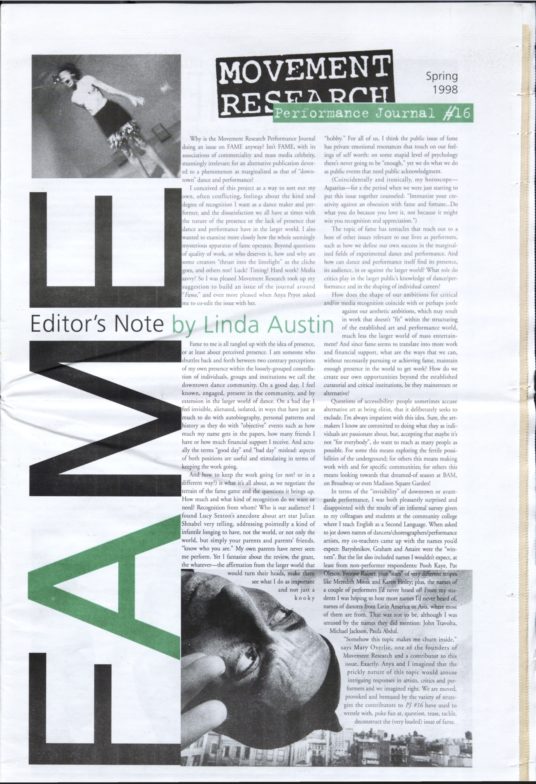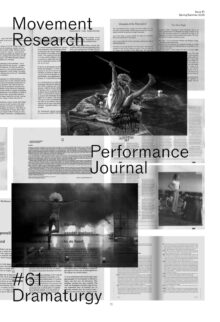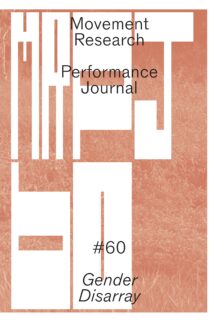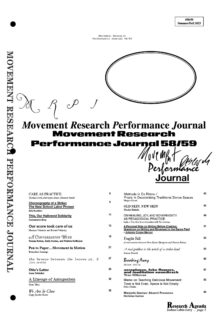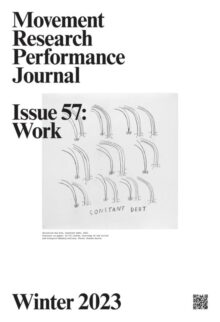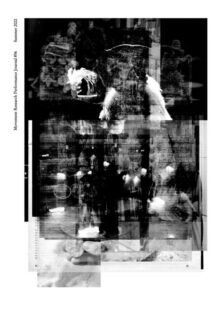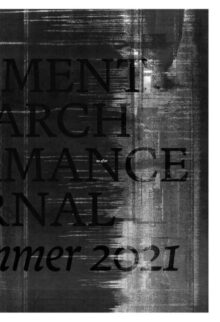This issue is OUT OF PRINT.
Editor’s Note
Why is the Movement Research Performance Journal doing an issue on FAME anyway? Isn’t FAME, with its associations of commerciality and mass media celebrity, stunningly irrelevant for an alternative publication devoted to a phenomenon as marginalized as that of “downtown” dance and performance?
I conceived of this project as a way to sort out my own, often conflicting, feelings about the kind and degree of recognition I want as a dance maker and performer, and the dissatisfaction we all have at times with the nature of the presence or the lack of presence that dance and performance have in the larger world. I also wanted to examine more closely how the whole seemingly mysterious apparatus of fame operates. Beyond questions of quality of work, or who deserves it, how and why are some creators “thrust into the limelight” as the cliche goes, and others not? Luck? Timing? Hard work? Media savvy? So I was pleased Movement Research took up my suggestion to build an issue of the journal around “Fame,” and even more pleased when Anya Pryor asked me to co-edit the issue with her.
Fame to me is all tangled up with the idea of presence, or at least about perceived presence. I am someone who shuttles back and forth between two contrary perceptions of my own presence within the loosely-grouped constellation of individuals, groups and institutions we call the downtown dance community. On a good day, I feel known, engaged, present in the community, and by extension in the larger world of dance. On a bad day I feel invisible, alienated, isolated, in ways that have just as much to do with autobiography, personal patterns and history as they do with “objective” events such as how much my name gets in the papers, how many friends I have or how much financial support I receive. And actually the terms “good day” and “bad day” mislead: aspects of both positions are useful and stimulating in terms of keeping the work going.
And how to keep the work going (or not? or in a different way?) is what it’s all about, as we negotiate the terrain of the fame game and the questions it brings up. How much and what kind of recognition do we want or need? Recognition from whom? Who is our audience? I found Lucy Sexton’s anecdote about art star Julian Shnabel very telling, addressing pointedly a kind of infantile longing to have, not the world, or not only the world, but simply your parents and parents’ friends, “know who you are.” My own parents have never seen me perform. Yet I fantasize about the review, the grant, the whatever—the affirmation from the larger world that would turn their heads, make them see what I do as important and not just a k o o k y “hobby.” For all of us, I think the public issue of fame has private emotional resonances that touch on our feelings of self worth: on some stupid level of psychology there’s never going to be “enough,” yet we do what we do as public events that need public acknowledgment.
(Coincidentally and ironically, my horoscope—Aquarius—for a the period when we were just starting to put this issue together counseled: “Immunize your creativity against an obsession with fame and fortune…Do what you do because you love it, not because it might win you recognition and appreciation.”)
The topic of fame has tentacles that reach out to a host of other issues relevant to our lives as performers, such as how we define our own success in the marginalized fields of experimental dance and performance. And how can dance and performance itself find its presence, its audience, in or against the larger world? What role do critics play in the larger public’s knowledge of dance/performance and in the shaping of individual careers?
How does the shape of our ambitions for critical and/or media recognition coincide with or perhaps jostle against our aesthetic ambitions, which may result in work that doesn’t “fit” within the structuring of the established art and performance world, much less the larger world of mass entertainment? And since fame seems to translate into more work and financial support, what are the ways that we can, without necessarily pursuing or achieving fame, maintain enough presence in the world to get work? How do we create our own opportunities beyond the established curatorial and critical institutions, be they mainstream or alternative?
Questions of accessibility: people sometimes accuse alternative art as being elitist, that it deliberately seeks to exclude. I’m always impatient with this idea. Sure, the art-makers I know are committed to doing what they as individuals are passionate about, but, accepting that maybe it’s not “for everybody”, do want to reach as many people as possible. For some this means exploring the fertile possibilities of the underground; for others this means making work with and for specific communities; for others this means looking towards that dreamed-of season at BAM, on Broadway or even Madison Square Garden!
In terms of the “invisibility” of downtown or avantgarde performance, I was both pleasantly surprised and disappointed with the results of an informal survey given to my colleagues and students at the community college where I teach English as a Second Language. When asked to jot down names of dancers/choreographers/performance artists, my co-teachers came up with the names you’d expect: Baryshnikov, Graham and Astaire were the “winners”. But the list also included names I wouldn’t expect, at least from non-performer respondents: Pooh Kaye, Pat Olezco, Yvonne Rainer, plus “stars” of very different stripes like Meredith Monk and Karen Finley; plus, the names of a couple of performers I’d never heard of! From my students I was hoping to hear more names I’d never heard of, names of dancers from Latin America or Asia, where most of them are from. That was not to be, although I was amused by the names they did mention: John Travolta, Michael Jackson, Paula Abdul.
“Somehow this topic makes me churn inside,” says Mary Overlie, one of the founders of Movement Research and a contributor to this issue. Exactly. Anya and I imagined that the prickly nature of this topic would arouse intriguing responses in artists, critics and performers and we imagined right. We are moved, provoked and bemused by the variety of strategies the contributors to PJ #16 have used to wrestle with, poke fun at, question, tease, tackle, deconstruct the (very loaded) issue of fame.
Linda Austin
